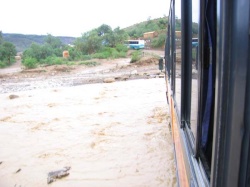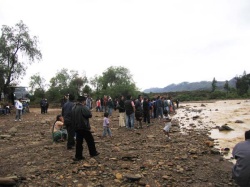Bus Ride to Sucre
12 December, 2007, 11:04 am in "Bolivia"
 I don't want to be one of those travelers who end up writing too much about bus trips, bus stations and other transport related items. But this one needs noting.
I don't want to be one of those travelers who end up writing too much about bus trips, bus stations and other transport related items. But this one needs noting. We had Andres at the Andoriņa Hostel reserve seats for us on the Flota Copacabana bus "cama" (bed) to Sucre. The bus company he usually books with had one of their busses break down so weren't going to Sucre that night. Our other choice was to stand by the road and flag down a bus. All the buses from Santa Cruz to Sucre use the highway that goes by Samaipata. However, there was a risk they wouldn't have room. Andres told us our reservations were set and we should be at the tranca a police toll booth, at 7PM for a bus that would arrive around 7:30. He also mentioned, since they don't usually pick up passengers, we should be sure to wave and jump in front of the bus to make sure they noticed us.
In the afternoon we walked down to the road to find the tranca. There was none in sight. We asked some people and an American hostel owner rushed up to inform us that the tranca didn't exist anymore. Consequently the buses wouldn't stop there. We were also told that all the buses now stopped at the turnoff to the village.
We told Andres this and he went and checked with the police. It turns out that 5 days before, the tranca had been removed because the toll collected there went to La Paz and Santa Cruz wanted autonomy (a very hot topic right now). So a new tranca would be built at some point and the tolls would stay in the province. For us, the most important thing was that we'd be catching the bus at the turn off which was a shorter walk anyway.
To be safe, we reached the road at 6:45. The buses started rolling by a bit after 7. We positioned ourselves with Rowshan a block ahead so he could read the bus name and signal to me to stop it (if it didn't stop for him). By now it was dark. 7:30 passed... and 8:30. We wondered when we should give up and go back to the hostel. A Flota Copacabana bus went by and didn't stop. Rowshan ran down the street and managed to ask if it was the bus "cama", as it slowed for a speed bump. The conductor said it wasn't and that the bus "cama" was behind somewhere.
Our bus finally showed up about quarter past 9. The conductor handed us our tickets which were for the 2nd row from the back.
Now, one of the tour agency guys we talked to (who informed us of the possibility of just flagging down busses by the road between 6 and 8:30 PM) distinctly said the buse only sold tickets if they had seats so we wouldn't have to worry about getting on a bus and having to stand in the aisle all the way to Sucre. He was wrong. As we picked our way through the bunches of people sleeping in the aisles, I was glad we'd bought tickets in advance with seat numbers. Our seats, however, contained an old man and a woman with a baby. The conductor kicked them out onto the floor. I offered to leave the bus (another day in Samaipata definitely would not be a sacrifice) if the conductor would refund our money, but he said that wasn't possible.
The bus made a meal/bathroom stop. Rowshan looked at the other buses and saw they were equally or more packed. He asked a fellow passenger about the price (since it was the most expensive ticket we'd bought in Bolivia and the other night buses we'd taken never had people sleeping in the aisles). The passenger said it was a difficult road and we were getting into the holiday season.
Late at night, or early morning, the bus stopped again and remained that way for a while. Soon we heard the metalic clanking of tools and realized they were changing a flat tire. This took an hour or so. We eventually got back on the road only to make another stop (for breakfast) during which they changed the tire again (though maybe it was just from a spare to a regular tire).
A couple hours later, the bus stopped again. This time things didn't look too good. There was a long line of buses and trucks stretching up the road in front of us. All had their engines stopped. People were walking back and forth along the line of vehicles. I got out and walked up the road, recognizing the buses that had passed us earlier as we had waited in Samaipata. In front of the first bus a rushing river was blocking the road. Lots of people stood by the river gazing at the opposite shore.

I surveyed the river looking for a way to get across by foot. I saw one point where we might have been able to leap from one rock to another but definitely not while carrying our bags. Further down the street, on the opposite side, was a village. The surroundings had sparce bushes, hills and cactus. I went back to the bus and Rowshan took a walk to see the river. Then he came back and we waited.
...and waited...
Finally, I guess the bus in front decided the water had lowered enough (or was just tired of waiting). The engines started up and the drivers honked signalling to their passengers.
One by one the vehicles plowed through the water and once again we were on our way. It was probably around 9, the time the bus should have been in Sucre.
The rest of the trip was fairly uneventful. We arrived in Sucre 4 or so hours late but very happy to be getting off that bus.
Comments
- Comments
Powered by My Blog 1.69. Copyright 2003-2006 FuzzyMonkey.net.
Created by the scripting wizards at FuzzyMonkey.net..
(Code modified by Rowshan Dowlatabadi)
Created by the scripting wizards at FuzzyMonkey.net..
(Code modified by Rowshan Dowlatabadi)

